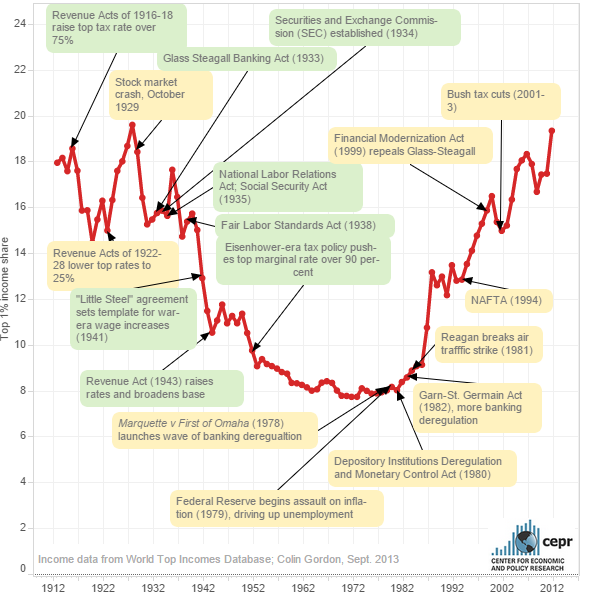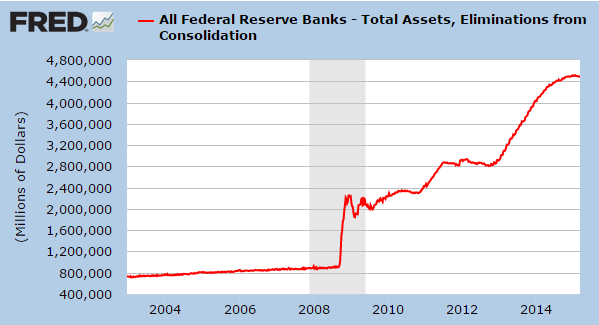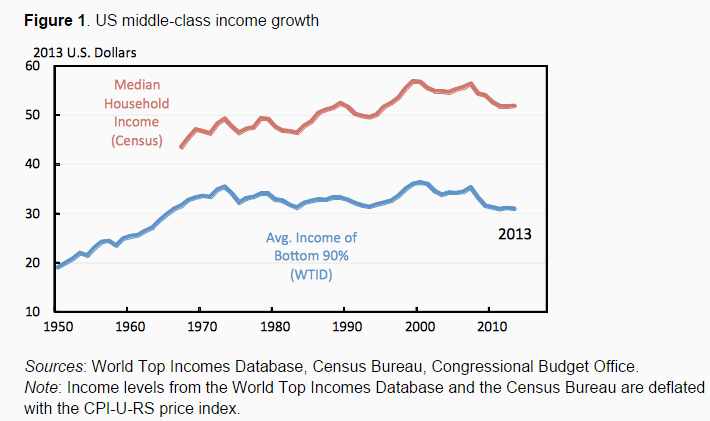March 18, 2015
The Fed has taken a page out of George Orwell’s 1984. Doublespeak is all the rage and the Fed’s statements are analyzed as if sifting for gold. Even when they don’t do anything markets jump. The Fed sets the tone on our debt addiction. The Fed dropped the word “patient” in terms of increasing interest rates but then goes on to say this doesn’t mean that it will be impatient. Say what? The Fed hints at tapering and balks because it claims there is “low inflation” but when we look at real inflation, the price of many items is shooting up dramatically. Many of these items were staples of the middle class including an affordable college education, a home, and being able to earn a good wage. Back in 1975 roughly 7 percent of all income earned went to the top 1 percent. Today it is closer to 20 percent. The last time it was this high was during the years prior to the Great Depression.
Share of income
The middle class is being dismantled by economic forces. More Americans find that they are working in the low wage economythat is booming. For most households income does matter because this is how you finance your life. The Fed has created a system where savers are punished. Negative interest rates punish traditional savings. It makes stocks, junk bonds, and other speculative items seem more lucrative. Those that take on big levels of debt are encouraged. So it is no surprise then that all items financed by debt are suddenly going up in price: housing (mortgages), college (student debt), and cars (auto debt). Yet the larger gains are not trickling down to workers.
Take a look at this chart showing the share of income earned by the top 1 percent:
It is no coincidence that after World War II in 1945 all the way to 1980 was the time the US middle class thrived the most. It was also a time when the top 1 percent were earning roughly 7 percent of all total income. When you put more dollars into the hands of middle class Americans, that money will get spent. However, aggregate the money into fewer hands and you see what we have today. An army of struggling Americans while a smaller group is pushing up the price on luxury goods and in finance, is creating a new rentier class.
The Fed realizes how addicted Americans are to debt. This headline speaks of 1984:
The markets of course responded positively to this. It only adds to the confusion. The Fed has kept rates in negative territory for many years now. Those saying there is no inflation are failing to look in obvious places. All you need to do is look at the Fed balance sheet and you realize there is no pulling back in this trend:
The Fed is playing the confidence card. They are trying to sway markets with anticipation. Like the man always telling his anxious girlfriend that “someday” in the future he will pop the question but never does. Actions speak louder than words. Look at the Fed balance sheet. The balance sheet tells us the Fed is incredibly impatient in restoring balance and is doubling-down on this debt based rally.
The middle class is falling behind:
Incomes have gone stagnant for well over a decade for middle class families. During this time, the share of income going to the top 1 percent has more than doubled. Those with the ability to leverage debt or more importantly, create money by full on monetization are the power brokers in this system. The Fed is out of tricks and is now resorting to doublespeak. The public is left dealing with a trend of low wage jobs and is being pushed into utilizing debt to chase the artifacts of middle class life. The market is severely under pricing the risk of too much debt once again.





No comments:
Post a Comment